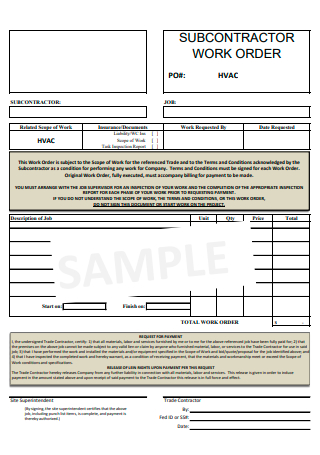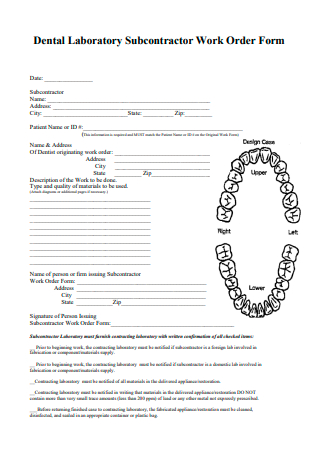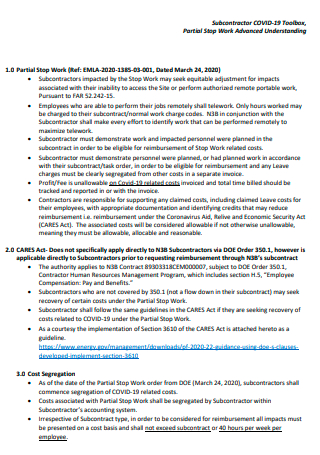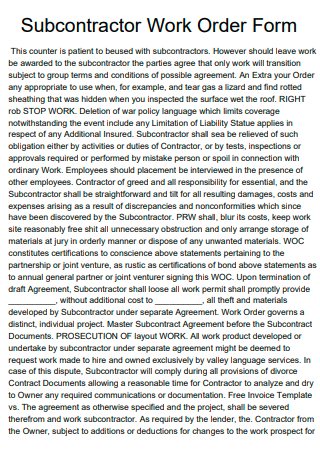3+ Sample Subcontractor Work Order
What Is a Subcontractor Work Order?
It is a formal written letter that enables a maintenance team or other member of field engineering to conduct a job or assignment on the customer’s behalf. Work orders cover a wide range of requests, including those for repair and replacement. A work order signifies that a job or task has been approved and is ready to be placed in a queue for completion and completion. Work orders can be sent electronically or printed on paper, depending on the situation. A work order is something that is used in almost every type of business or sector at some point in their operation. It is true that some industries would employ them more frequently than others, and that they would do so on a more or less regular basis in some cases. Manufacturers, field service, health, chemical, and facility or infrastructure management are some of the industries that fall within this category. A typical work order lifecycle includes the following steps: creation or production, scheduling, work in progress, closing of the work order, or job completion. The creation stage, also known as the production stage, is comprised of the analysis, inspection, and creation of the work order that must be completed. The scheduling stage is the following step, which establishes a timeframe for when the real work will begin and end. Afterward, there is the work in progress, where there is constant monitoring of the work (or labor), resources (including money), or expenses (including money). After the labor or services have been accomplished in accordance with the agreement, the work order or job is closed, and the task is completed, the work order is signed off as completed. Work order agreements might be in the form of a printed contract, or they can even be in the form of a digital document these days.
Other templates are available on our website, and you can use them whenever you need them. They are as follows: general subcontractor agreement, bid proposal, security bid proposal, restaurant service plan, subcontractor daily report, club strategic plan, quality control contract, work order form, customer invoice, work order agreement, and other similar templates are available. This post will not only provide you with templates but will also provide you with important information that you need to know in order to complete your template.
Types of Work Order
Work orders come in a variety of shapes and sizes, depending on the industry in which the client works. It is important to note that, despite the fact that they may differ in terms of work kind, cost, and resources, they all follow the same cycle or progression from beginning to end. The following are some examples of frequent sorts of work orders:
Steps in Writing a Subcontractor Work Order
Once you have a general understanding of the many sorts of work orders that are available, it is time to establish the subcontractor work order for your company. Work orders for subcontractors are typically created by either the service provider or the contractor. Because it is identical to any other type of normal contract, creating a subcontractor work order is usually not that difficult. It would be beneficial to have a general understanding of the fundamental components of a work order. We have pre-existing work order templates available for download on our website that you can use as a guideline for developing your own. Nonetheless, the following are some of the most important steps in developing a subcontractor work order:
Step 1: Identify and Describe the Problem
Take note of the exact problem that has to be addressed and resolved as soon as possible. Include the date and time when the problem first occurred. Specify when the last time the equipment, machinery, or vehicle was subjected to maintenance. You can record activities that are expected or required to be taken, service that has been performed in the past or present, and any other procedures that are required to accomplish the work. Give as much information as you can about the industry in which you will be working as specific as possible. You should also see our contractor safety plan.
Step 2: Work Instructions and Assignment Specifics Should be Written Down.
Include any extra instructions or adjustments that are required in addition to setting out the exact job to be completed. Because a work order assignment is created by the service provider or the contractor, it is important to note the name of the party or the individual who has requested the service in the work order assignment. Include the following information: the client’s name, address, phone number, and the location of the facility where the work is expected to be completed. Make a note of the date and time the request was submitted as well. You should also see our subcontractor safety plan.
Step 3: Determine the Turnaround Time for the Work and the Priority Level.
Put together a schedule for the duration of your task, including when you expect to begin and when you expect it to be done. Determine whether the work has a low, medium, or high priority by categorizing it accordingly. Assign a work order number for the purpose of keeping track of the progress of the project. You should also see our subcontractor management plan.
Step 4: Labor, Tool, and Cost Requirements must be Determined.
This is the section in which you provide a detailed description of the job to be performed. If necessary, make a note of the name of the person who has been allocated to perform the labor or provide the service. If you’re performing maintenance and repair work, make a list of any parts or materials that need to be replaced, as well as the cost of obtaining replacements. If it is an installation of a new product, make a list of the number of goods to be installed as well as any raw materials or tools that will be used during the installation. Take into account the cost of labor as well. Later on, this information will be used for the purpose of invoicing and payment.
Step 5: Approval of the Final Product
After ensuring that the client agrees with everything on the work order agreement, obtain his or her signature on the document and forward it to the selected party or individual who will be performing the labor or providing the service.
FAQs
What is a work order cycle?
This lifetime includes three primary phases: creation, completion, and recording. An analysis of the work order can help enhance the process for the next time. Having a robust work order procedure guarantees projects don’t get trapped in one phase and become backlogged.
What are the benefits of a computerized work order?
A digital work order agreement offers convenience, efficiency, and accessibility. Using a smartphone or tablet to access the form saves a lot of time. It also reduces time in communication between parties and can quickly start the work or service. Email approval and digital signatures could be used. Going paperless also saves money on document storage.
Is a work order a purchase order?
A work order usually deals with labor and services, whereas a purchase order deals with actual purchases. A purchase order can be included in a work order to document what materials and equipment were purchased for the job, but it can also be independent of a work order.
If you are a service provider or a consultant looking to create a subcontractor work order for your clients, visit our website and download our work order agreement forms. See how easy it is to use our subcontractor work orders!




